Home Decor
Creative Decorating Ideas With Topiaries
Yearning to elevate your home's décor with a touch of elegance?
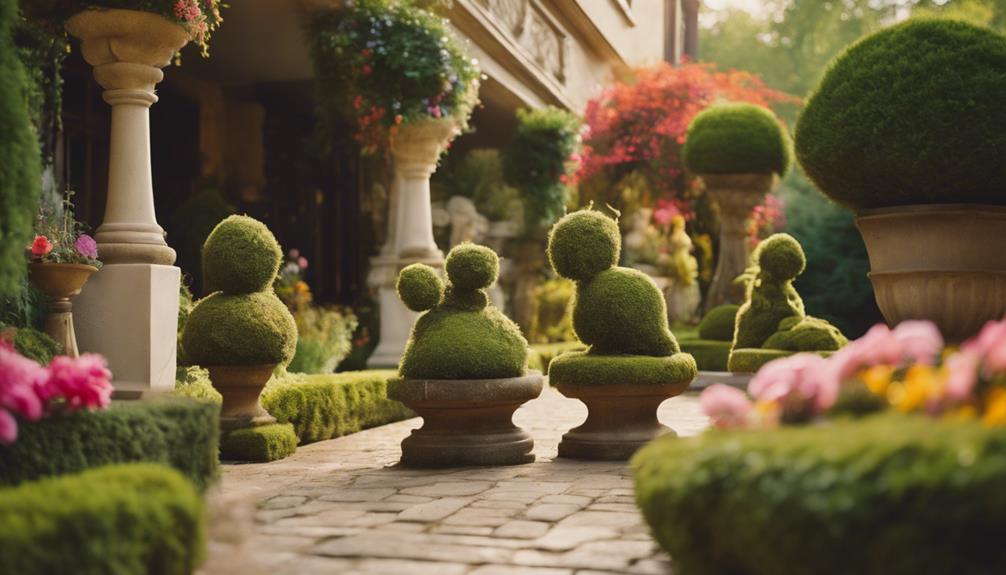
With topiaries, you can elevate your home's décor by adding a touch of elegance and sophistication, whether you're looking to accentuate a specific room or create a stunning outdoor display. From whimsical shapes and designs to unique frame ideas, the possibilities are endless. Combine topiaries with houseplants for a visually appealing display, or use them as a focal point in your outdoor space. Regardless of your style, topiaries can bring a level of sophistication to any room. Explore the world of topiary decorating, and discover how you can use these living works of art to transform your space.
Key Takeaways
• Use topiaries in unique shapes and sizes to add visual interest and whimsy to any room or outdoor space.
• Combine topiaries with houseplants to create visually appealing displays that mix textures and proportions.
• Create a themed topiary display by using seasonal elements and colors, such as autumn leaves or winter snowflakes.
• Experiment with unusual topiary frames, like vintage suitcases or wooden urns, to add personality to your decor.
• Group topiaries of varying heights and sizes to create a visually appealing focal point or add visual interest to a room or outdoor space.
Topiary Inspiration for Every Room
Whether you're revamping your living room, bedroom, or outdoor space, topiaries can bring a touch of elegance and sophistication to every corner of your home. Topiaries can add architectural presence and enhance aesthetics in any room, making them an excellent addition to your home decor.
By placing them on dining buffets and kitchen shelves, you can elevate the decor and create a more refined atmosphere. To add some personality to your space, try sculpting plants like Myrtle or using fern moss to create intricate and cheery accents.
Topiaries in various shapes and sizes can provide visual interest and depth to a space, making them a versatile decorating option. By incorporating topiaries in different containers and placements, you can bring a fresh and elegant look to your home decor.
With their ability to add a touch of sophistication to any room, topiaries are a great way to take your home decor to the next level.
Whimsical Shapes and Designs

As you explore the world of whimsical topiary designs, you'll discover a domain of creative possibilities, from floral fantasy forms that evoke a sense of enchantment to whimsical wireframes that add a touch of playfulness to any space.
You'll learn how to craft nature's sculpted art, transforming ordinary plants into extraordinary centerpieces that become the focal point of any room.
Floral Fantasy Forms
With topiary art, you can set free your creativity by crafting whimsical shapes and designs that transport you to a floral fantasy world. Floral fantasy forms involve creating unique and imaginative shapes and designs with topiaries, ranging from animals and objects to intricate patterns and characters. These forms add a playful and artistic touch to indoor and outdoor spaces, making them a great way to decorate with topiaries.
To achieve these intricate designs, skilled shaping and trimming techniques are required.
Here are some examples of floral fantasy forms you can create:
| Form | Description |
|---|---|
| Animal Shapes | Create topiaries in the shape of animals, such as dogs, cats, or birds |
| Geometric Patterns | Design intricate patterns, such as spirals or chevrons, using topiaries |
| Objects | Craft topiaries in the shape of objects, like flowers, clouds, or even food items |
| Characters | Bring popular characters, like cartoon figures or mythical creatures, to life with topiaries |
Whimsy in Wireframes
You can add a touch of personality to your space by incorporating whimsical wireframe topiaries that playfully deviate from traditional decor. These unique topiaries come in a variety of shapes, from animals to geometric figures and intricate designs, offering endless possibilities for creative expression.
By incorporating a wireframe topiary into your decor, you can create a unique focal point in any room or garden. Plus, since they can be used indoors or outdoors, you can get creative with your display.
One of the best things about wireframe topiaries is that they can be customized to fit your personal style. Whether you prefer bold and bright or subtle and understated, you can design a topiary that reflects your individuality. With wireframe topiaries, the possibilities are endless, and you can let your imagination run wild.
Nature's Sculpted Art
Beyond the wireframe whimsy, nature's sculpted art takes center stage, offering an array of whimsical shapes and designs that bring a touch of playfulness to any space.
As you explore the world of topiaries, you'll discover that these living sculptures can be crafted into various whimsical shapes, such as animals, spirals, hearts, and letters, adding a playful and artistic touch to your decor.
Boxwood topiaries, in particular, are popular for their versatility and ease of maintenance. With topiaries, you can create a unique and eye-catching decor element that showcases nature's artistic beauty.
Whimsical shapes and designs bring a sense of charm and personality to indoor and outdoor settings, making them a great way to add some personality to your space.
Whether you choose a traditional spiral or a more abstract form, topiaries are sure to bring a touch of whimsy and creativity to your decor.
Indoor Topiary Decorating Ideas
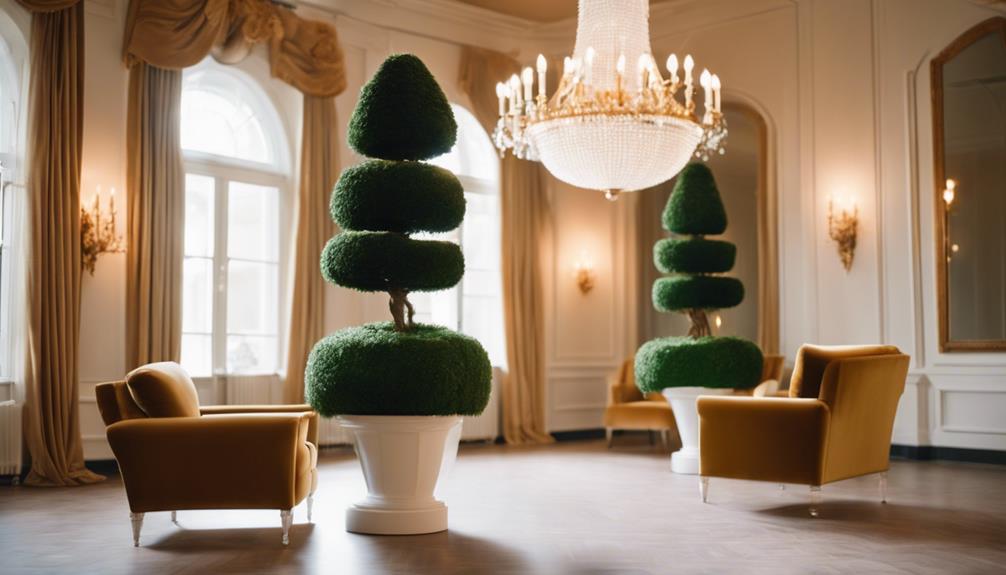
As you explore indoor topiary decorating ideas, you'll discover that creating focal points with topiaries can elevate the ambiance of any room.
You can also get creative by filling vases with lush greenery or designing whimsical centerpieces that become conversation starters.
Focal Point Creations
To create a stunning focal point in your living room, place a majestic topiary on a decorative pedestal or console table, drawing the eye towards the area. This strategic placement will instantly elevate the ambiance of the room, making it feel more sophisticated and inviting. By incorporating a topiary into your decor, you can create a beautiful visual anchor that guides the viewer's attention.
Imagine a lush topiary garden, carefully crafted to make a statement in your home. To make a topiary, you can choose from a variety of shapes, sizes, and plant species, allowing you to customize the look to fit your unique style. By placing a topiary in a prominent location, you can create a sense of drama and elegance, adding depth and visual interest to the space.
Whether you're looking to revamp your living room, dining room, or entryway, a well-placed topiary can be a game-changer, drawing attention to the area and showcasing your personal taste.
Greenery Filled Vases
You can instantly elevate your indoor spaces by filling vases with lush topiaries, adding a touch of nature and sophistication to any room.
This decorating idea is especially great because it's low-maintenance, allowing you to bring in some greenery without the hassle of constant care.
Plus, vases filled with topiaries are incredibly versatile – you can place them on mantels, shelves, or even use them as a centerpiece on tables.
One of the best things about this decor element is that it can be easily customized to match your unique style or color scheme.
Whether you prefer modern and sleek or traditional and ornate, there's a vase and topiary combination that will fit seamlessly into your space.
By incorporating topiaries into your decor, you'll not only add some natural beauty but also create a sense of elegance and refinement.
With so many possibilities, it's no wonder vases filled with topiaries have become a popular choice for indoor decorating.
Whimsical Centerpieces
By adding a whimsical centerpiece to your dining table or mantel, you can instantly create a focal point that draws the eye and sparks conversation. Indoor topiaries make perfect centerpieces, adding a touch of greenery and elegance to any room. To create a unique display, mix and match different topiary shapes and sizes, and decorate them with ribbons, fairy lights, or seasonal accents for a festive look.
Here are some ideas to get you started:
| Topiary Style | Container |
|---|---|
| Beautiful boxwood | Vintage urn |
| Small spheres | Wooden planter |
| Cone-shaped | Woven basket |
| Mini trees | Ceramic pot |
| Round topiary | Glass vase |
Place a beautiful boxwood topiary on your coffee table or mantel to create a stunning centerpiece. You can also group a few small topiaries together on a decorative tray or platter to create a visually appealing display. With a little creativity, you can create a whimsical centerpiece that adds a touch of elegance to any room.
Outdoor Topiary Display Concepts
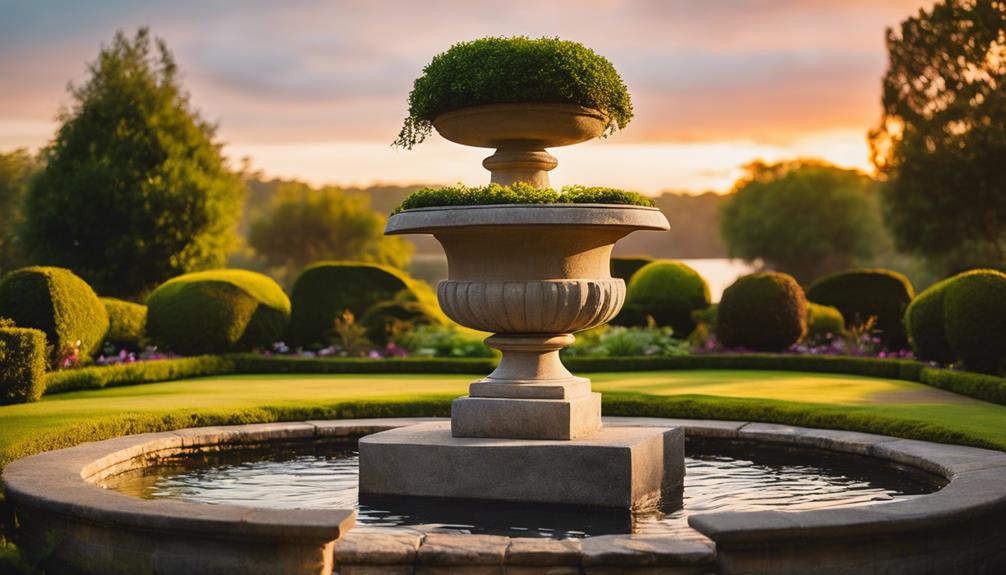
Outdoor topiary displays can elevate your garden or patio's ambiance with unique arrangements that showcase your personal style. By incorporating different plant types, such as boxwood, juniper, or rosemary, you can create diverse outdoor topiary displays that reflect your personality.
Outdoor topiaries can range from classic geometric shapes to whimsical animal designs, serving as focal points, accents, or even privacy screens in your outdoor spaces. When planning your outdoor topiary display, consider the maintenance requirements, including regular pruning, watering, and monitoring for pests or diseases.
With proper care, outdoor topiaries can withstand various weather conditions and add a touch of elegance to your garden or patio. By experimenting with different plant types and arrangements, you can create a unique outdoor topiary display that complements your outdoor space and expresses your personal style.
Topiary and Houseplant Combos

What if you could merge the elegance of topiaries with the versatility of houseplants to create a show-stopping decor that's uniquely yours? By combining these two elements, you can create a dynamic and visually appealing space that showcases your personal style.
Here are a few topiary ideas to get you started:
- Mix and match textures: Combine smooth-leaved houseplants with topiaries featuring intricate designs or bold shapes to add depth and visual interest.
- Play with proportions: Pair small topiaries with larger houseplants or vice versa to create a striking contrast that draws the eye.
- Experiment with arrangements: Group topiaries and houseplants together to create a lush, green focal point in a room, or scatter them throughout your space for a more subtle look.
Unique Topiary Frame Ideas

Transform your topiaries into one-of-a-kind masterpieces by repurposing unexpected containers that add an extra layer of personality to your decor. You can create a unique look by using vintage suitcases or old books as frames for your topiaries. These unconventional containers will add a touch of eclecticism to your space. If you want a more traditional look, consider using wooden urns or cloches to add depth and visual interest to your topiaries.
Here are some unique topiary frame ideas to inspire you:
| Container | Description |
|---|---|
| Vintage Suitcase | Adds a touch of nostalgia and eclecticism |
| Wooden Urn | Provides a natural, earthy feel |
| Clay Pots | Look good with moss-covered tops for a natural aesthetic |
| Cloche | Adds a touch of elegance and sophistication |
| Old Books | Creates a whimsical, literary-inspired decor |
Seasonal Topiary Decorating Tips

To maintain your topiaries looking fresh and festive, update your decorations with the changing seasons by incorporating seasonal elements, colors, and accessories that reflect the current time of year. This will guarantee that your collection of topiaries remains fresh and exciting throughout the year.
Here are some seasonal topiary decorating tips to keep in mind:
- Autumn: Use topiaries shaped like pumpkins or incorporate autumn leaves into your decor to create a cozy atmosphere.
- Winter: Opt for white pompoms or frosted glass decorations to give your topiaries a winter wonderland feel.
- Thanksgiving: Create a themed topiary, like a pumpkin topiary, to add a touch of festive charm to your home.
Topiary Maintenance and Care

You'll need to prune your topiaries regularly during the growing season to maintain their shape and promote healthy growth. This is essential to make your topiaries thrive and look their best. When pruning, use clean and sharp tools to prevent spreading diseases and to make clean cuts.
Choose topiary plants like boxwood, yew, holly, or rosemary that are suitable for shaping, and consider plants like ligustrum and English yew if you want to place them in shade.
As you tend to your topiaries, remember that consistent monitoring is key to their well-being. Keep an eye out for pests, diseases, and watering needs, and take action promptly if you notice any issues. By doing so, you'll show your topiaries the love and care they need to flourish.
With regular pruning and monitoring, you'll make your topiaries a stunning addition to your home or garden. By following these simple care tips, you'll be able to enjoy your beautiful topiaries for years to come.
Creative Topiary Placement Ideas

By strategically placing topiaries in your home or garden, you can create a unique and enchanting ambiance that reflects your personal style.
To take your decor to the next level, consider the following creative topiary placement ideas:
Accentuate architectural features: Place topiaries in alcoves or niches for a unique and elegant touch to your decor. This will draw attention to the beautiful features of your home and make it look amazing.
Create a grand entrance: Use topiaries to frame a fireplace or entryway for a grand and welcoming statement. This will set the tone for the rest of your home's decor.
Add visual interest: Group topiaries in varying heights and sizes for a visually appealing display in any room. This will add depth and texture to your space, making it more engaging and inviting.
Frequently Asked Questions
Are Topiaries Still in Style?
You might be wondering, are topiaries still in style?
The answer is yes! Despite shifting design trends, topiaries have maintained their popularity as a timeless decor element.
Their versatility in styling and ability to bring a touch of nature indoors continue to appeal to interior designers and home decor enthusiasts alike.
In fact, many designers still use topiaries to add elegance and architectural interest to spaces, ensuring their enduring appeal.
How to Decorate With Topiary Balls?
You're likely wondering how to decorate with topiary balls, and the possibilities are endless!
Did you know that 70% of homeowners incorporate plants into their decor to boost ambiance?
To get started, decide on a theme or color scheme, then choose topiary balls that fit your style.
You can hang them, group them in containers, or use them as standalone accents.
Experiment with different sizes, materials, and arrangements to create a unique look that adds a touch of elegance to any space.
Where to Put Topiary Trees?
When deciding where to put topiary trees, you have plenty of options. You can place them indoors on mantels, dining tables, or kitchen counters to add a touch of greenery.
Alternatively, consider outdoor locations like front porches, entryways, or garden beds to enhance curb appeal.
You can also use topiaries to add a stylish element to living rooms, bedrooms, or home offices.
Are Topiary Trees in Style?
You're wondering, are topiary trees still in style? Well, let's get straight to it: yes, they are! Topiary trees have been a timeless decor element, and their popularity is on the rise.
They offer a classic, chic look that fits seamlessly into various design aesthetics, from traditional to modern.
As people seek unique decor pieces, topiary trees continue to be a popular choice for adding a touch of greenery and charm to any space.
Conclusion
As you explore the world of topiary decorating, don't be discouraged if your creations don't turn out perfectly at first. With practice, patience, and a willingness to experiment, you'll soon be crafting stunning topiary masterpieces that bring joy and elegance to any room.
Remember, the key to topiary success lies not in achieving perfection, but in embracing the journey and having fun along the way.
Vivienne – Your Content Companion Vivienne is your content companion, curating valuable tips, advice, and inspiration to guide you on your home decor journey. From insightful blog posts to informative product descriptions, she’s here to empower you with the knowledge you need to create your dream space.
Home Decor
Top Sustainable Rural Design Trends in Indonesia
Keen to discover how Indonesia blends tradition with innovation in rural design? Uncover the trends reshaping sustainable living and community resilience.
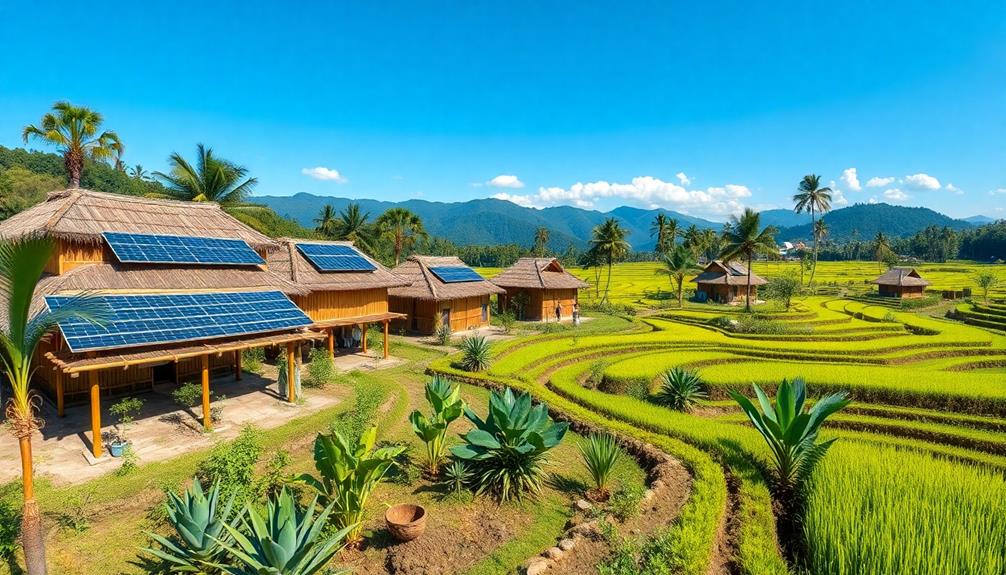
Top sustainable rural design trends in Indonesia focus on preserving cultural heritage while promoting ecological integrity. You'll see participatory design approaches that engage locals, ensuring their voices shape development. Traditional Ecological Knowledge, like Niteni and Pranatamangsa, enhances agricultural practices and fosters community ties. Community engagement strategies empower local craftsmanship and strengthen identities. Additionally, the Smart Villages concept utilizes technology to improve living conditions and promote entrepreneurship. These trends not only enhance resilience but also connect people to nature. If you're curious about how these elements come together for a sustainable future, there's much more to explore.
Key Takeaways
- Participatory design approaches empower communities by involving locals in the design process, ensuring their needs and cultural identities are prioritized.
- Traditional Ecological Knowledge (TEK) supports sustainable agriculture, utilizing techniques like Niteni and Pranatamangsa to enhance crop yields and biodiversity.
- Community engagement strategies promote local craftsmanship and traditions, strengthening community identity and fostering pride in cultural heritage.
- The Smart Villages concept utilizes ICT to enhance living conditions, promote local entrepreneurship, and support environmental stewardship in rural areas.
- Future directions focus on integrating TEK with luxury tropical design aesthetics, maintaining a connection to nature while promoting sustainable practices.
Impact of Industrialization on Rural Areas
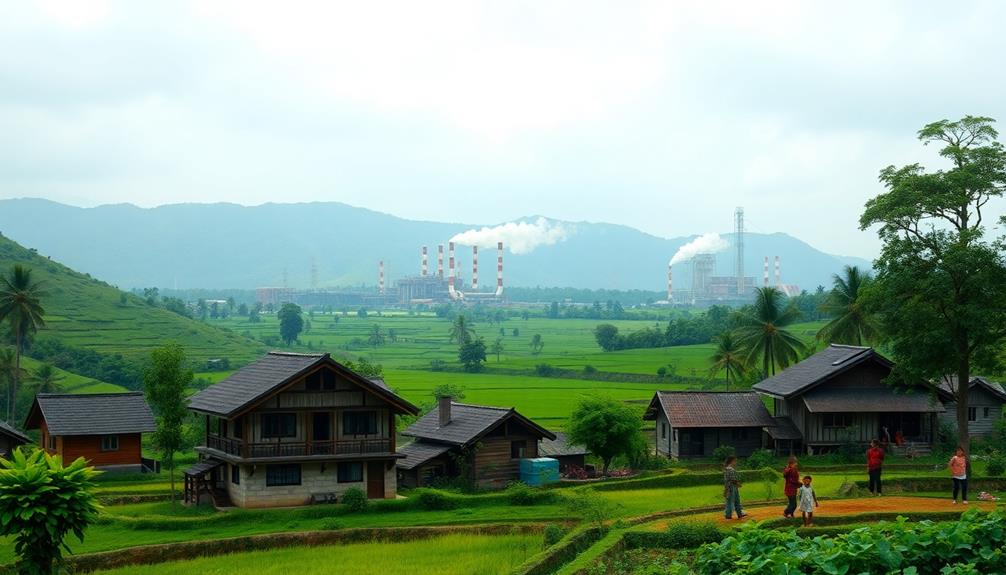
Industrialization in Indonesia has profoundly impacted rural areas, reshaping lives and landscapes alike. As you observe the shift from traditional farming to modern agricultural practices, you'll notice the erosion of cultural identities tied to these age-old methods.
The Green Revolution of 1968 marked a turning point, prioritizing economic growth over sustainable development, leading to significant environmental degradation and a loss of biodiversity. This transformation has also influenced traditional housing designs, as many rural communities are adapting to modern materials and construction methods, often at the expense of their cultural heritage and sustainability principles.
Traditional Indonesian houses typically utilize natural materials that promote sustainability, a practice that's increasingly overlooked in favor of contemporary building techniques.
Urbanization policies have exacerbated the economic divide, leaving rural poverty rates at 12.36% as of September 2022. This uneven development has disrupted not only local economies but also the community ties that once flourished around farming.
Mechanized practices have taken precedence, focusing on profit rather than ecological sustainability, which further contributes to the decline of traditional farming.
As you witness these changes, it becomes clear that the need for sustainable rural development in Indonesia is critical. By integrating traditional ecological knowledge into modern practices, you can help revitalize rural communities and preserve their cultural heritage amidst the pressures of industrialization.
Embracing sustainable design practices can pave the way for a more balanced approach that honors both economic growth and the environment.
Participatory Design Approaches
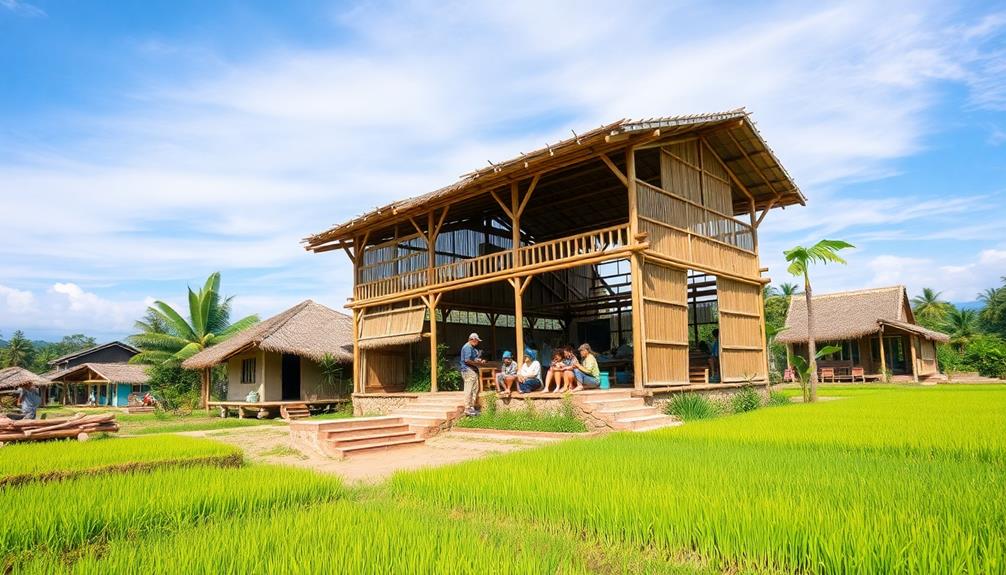
As rural communities in Indonesia face the challenges of modernization, participatory design approaches offer a solution that empowers locals by involving them directly in the design process. By treating community members as active contributors rather than passive subjects, you enhance local ownership and guarantee that projects are relevant to their needs.
This is particularly important in regions where traditional housing styles, such as Rumah Adat, reflect cultural significance and social status, emphasizing the need for designs that resonate with local identities.
The participatory design process includes activities like initiation meetings, treasure mapping, and idea generation workshops. These methods help identify community assets and guarantee all voices are heard. Engaging diverse stakeholders—such as local farmers and government representatives—fosters collaborative engagement to tackle local development challenges and promotes resilience in rural communities.
Additionally, utilizing ethnographic methods allows you to document local cultural practices, guaranteeing designs are informed by the unique context of the area. This approach supports sustainable development by integrating Traditional Ecological Knowledge, which enhances agricultural practices and strengthens regional identity.
Ultimately, participatory design not only addresses immediate needs but also nurtures a sense of community empowerment, setting a foundation for long-term ecological balance and sustainable growth in rural Indonesia.
Traditional Ecological Knowledge

In Indonesia, you'll find that Traditional Ecological Knowledge (TEK) plays a crucial role in sustainable agriculture through techniques like Niteni, which encourages careful observation of nature.
This approach aligns well with the use of natural materials in various aspects of Indonesian life, such as in Indonesian Kitchen Decor, where bamboo and wood enhance functionality and beauty.
By following the Pranatamangsa seasonal guidelines, farmers can align their practices with natural cycles, ensuring healthier crops.
Embracing TEK not only promotes environmental balance but also strengthens community ties and regional identity.
Niteni Observation Techniques
While many modern agricultural techniques focus on technology, Niteni observation techniques rooted in traditional ecological knowledge offer invaluable insights for sustainable farming in Indonesia. By engaging in Niteni, you can closely observe and document natural phenomena, allowing you to understand seasonal changes and ecological patterns that influence your farming practices.
This approach is essential for making informed decisions about when to plant and harvest, as guided by the Pranatamangsa calendar. Additionally, integrating elements of local culture, such as unique artistic expressions reflected in traditional crafts, can enhance community engagement and pride.
Niteni emphasizes the interconnection between human activities and nature, promoting sustainable living and ecological balance in rural areas in Indonesia. As you incorporate Niteni into your agricultural practices, you not only enhance your regional identity and local pride but also foster community engagement and empowerment.
This participatory design process supports the preservation of cultural heritage and biodiversity, key factors for sustainable development.
Utilizing Niteni in your farming methods can create a more resilient agricultural system that respects local traditions while adapting to modern challenges. By embracing these traditional observation techniques, you contribute to a sustainable future that honors both your community and the environment.
Pranatamangsa Seasonal Guidelines
Building on the insights gained from Niteni observation techniques, the Pranatamangsa seasonal guidelines offer a structured approach to agricultural timing in Indonesia. This traditional ecological knowledge system helps you optimize your agricultural activities by aligning planting and harvesting times with natural indicators.
By observing local weather patterns, moon phases, and ecological changes, you can enhance crop yields and better manage your resources. This approach resonates with the principles of Balinese design characteristics, which emphasize sustainability and a connection to nature.
Incorporating Pranatamangsa into your farming practices not only supports sustainable development but also reinforces the cultural identity of rural Indonesia. This deep-rooted wisdom enables you to mitigate the risks of crop failure, promoting food security and environmental stewardship within your community.
As you embrace these seasonal guidelines, you contribute to the preservation of local ecosystems and biodiversity. Utilizing Pranatamangsa reflects the importance of traditional design in modern agriculture, reminding you that sustainable practices are rooted in respecting nature.
Community Engagement Strategies

When you engage with rural communities in Indonesia, using collaborative design approaches can notably enhance the outcome.
By integrating local knowledge, such as traditional craftsmanship and cultural symbols, you not only respect their traditions but also empower them to participate actively in the design process.
This aligns with the principles of Indonesian wedding decor ideas, fostering sustainable practices that resonate with the community's values and needs.
Collaborative Design Approaches
Engaging communities in the design process is essential for fostering sustainable rural development in Indonesia. By utilizing collaborative design approaches, you can guarantee that all community members participate in decision-making, leading to impactful social innovation. Participatory learning techniques, like initiation meetings and craft design workshops, actively involve stakeholders, making them co-creators of their environment.
Incorporating Traditional Ecological Knowledge (TEK) enriches the design by preserving local narratives and identities. Recently, a project included 58 participants—24 from the local community and 28 from outside—highlighting the significance of diverse stakeholder collaboration for effective rural development.
Here's a quick look at key aspects of collaborative design approaches:
| Aspect | Description |
|---|---|
| Participatory Learning | Engaging community in decision-making processes |
| Multi-Sector Collaboration | Involving diverse stakeholders for effective solutions |
| Social Innovation | Creating sustainable and innovative community-led projects |
Focusing on openness and connectedness encourages knowledge exchange, addressing local challenges through a holistic approach. By embracing these strategies, you're not just designing spaces; you're empowering communities to shape their futures sustainably.
Local Knowledge Integration
Integrating local knowledge into the design process greatly enhances community engagement strategies in rural Indonesia. By utilizing local knowledge integration, you tap into the rich resources of Traditional Ecological Knowledge (TEK), which fosters sustainable development. Engaging local stakeholders through participatory design allows you to create solutions that resonate with community values and needs.
Additionally, incorporating elements such as traditional artistry into your designs can further enrich the cultural significance of the projects.
In your approach, consider using ethnographic methods to document community life. This helps capture local perspectives that inform your design decisions, reinforcing cultural narratives and ensuring that your initiatives reflect the community's identity.
Activities like treasure mapping and craft design workshops encourage community empowerment, giving locals a sense of ownership over development projects.
Collaborative engagement with diverse stakeholders, including local farmers and government representatives, is essential for addressing local development challenges. By actively involving these groups in the design process, you promote social innovation that benefits everyone.
Case Study: Sabrang Village

Sabrang Village, nestled in Delanggu District, serves as a compelling example of sustainable rural design in Indonesia. This village is renowned for its rice production, yielding around 20,395 tons annually, thanks to the cultivation of local varieties like Rojolele and Mentik Wangi.
The community's commitment to sustainable development is evident through its participatory design practices, which engage 58 participants, including local farmers and external stakeholders. This collaboration fosters community involvement, ensuring that everyone has a voice in shaping their environment.
Moreover, the use of traditional Indonesian style home decor within village structures enhances the cultural significance and aesthetic appeal of the community.
Traditional Ecological Knowledge (TEK) plays an essential role in Sabrang's agricultural practices. Techniques like Niteni and Pranatamangsa guide farmers in observing natural phenomena and adhering to seasonal farming guidelines.
The village emphasizes traditional design that reflects local cultural values and craftsmanship, inspired by Japanese design traditions. This approach not only enhances identity-making but also strengthens community-building efforts.
Sabrang's focus on co-creation and participatory learning is key to enhancing the resilience of its agricultural practices and overall community life. By integrating these elements, Sabrang Village exemplifies how sustainable rural design can effectively harmonize cultural heritage with modern agricultural needs.
Smart Villages Concept
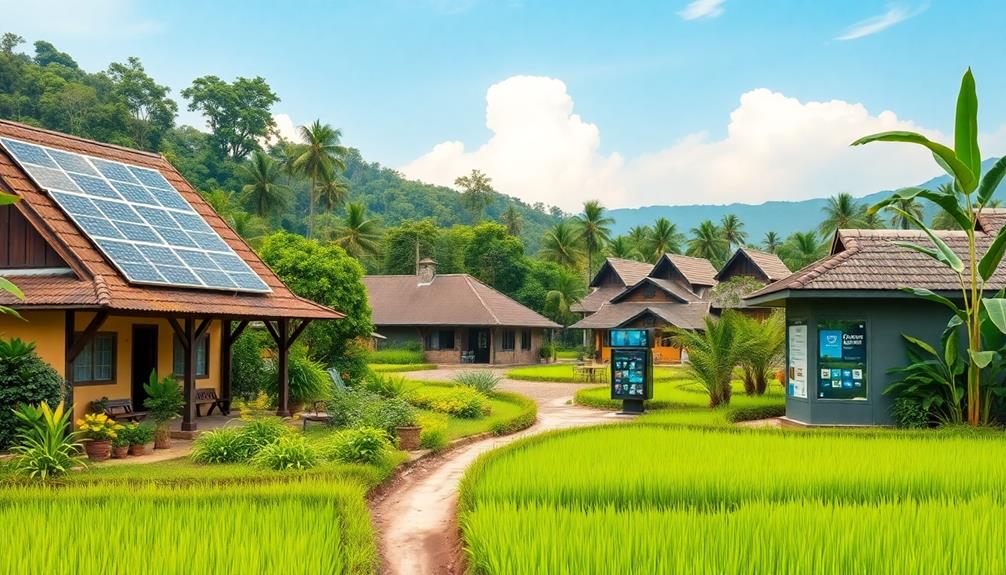
How can the Smart Villages concept transform rural life in Indonesia? By leveraging information and communication technology (ICT), Smart Villages enhance community resilience and promote sustainable development. This approach addresses vulnerabilities and improves local living conditions, fostering social inclusion and collective well-being.
| Key Elements | Benefits | Examples |
|---|---|---|
| ICT Integration | Improved access to services | Pondok Ranji for education |
| Local Entrepreneurship | Economic growth | Geluran Taman for language skills |
| Community Collaboration | Tailored solutions | Stakeholder engagement |
| Sustainable Practices | Environmental stewardship | Renewable energy initiatives |
The COVID-19 pandemic highlighted the need for Smart Villages, emphasizing their role in sustainable national development. As of 2022, 8.43% of villages were classified as Independent, while 27.34% were Developed, illustrating ongoing efforts to bridge rural disparities. Successful implementations demonstrate innovative strategies that attract investment and empower local entrepreneurs. By prioritizing community characteristics and input, Smart Villages can effectively meet local needs, fostering a resilient and inclusive rural environment. This transformation not only enhances living conditions but also paves the way for a brighter future for rural Indonesia.
Future Directions in Rural Design
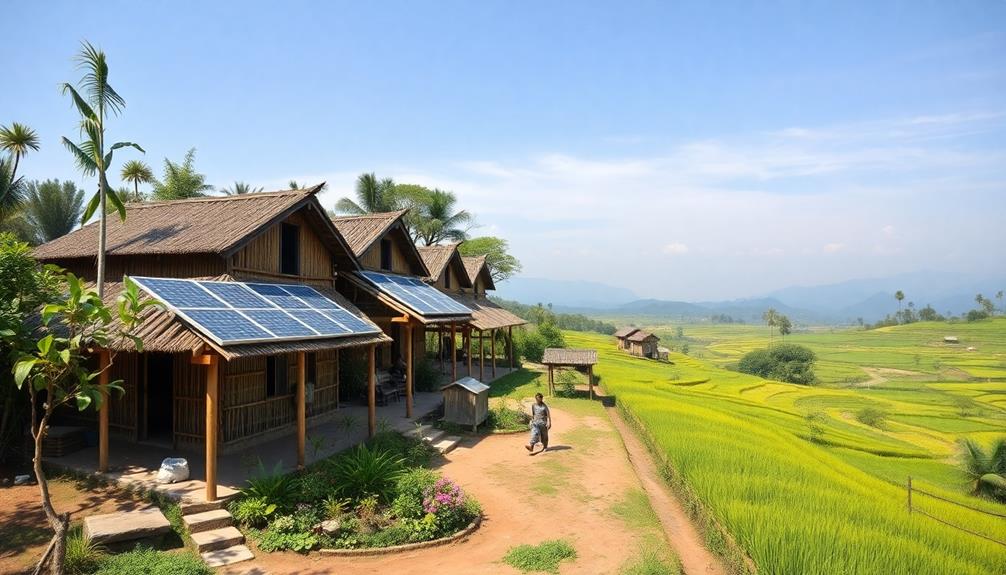
Embracing innovative approaches, future rural design in Indonesia is set to harness Traditional Ecological Knowledge (TEK) and smart village concepts to create sustainable environments.
By integrating TEK, you'll promote sustainable agricultural practices and enhance local biodiversity, drawing inspiration from methods like Niteni and Pranatamangsa, which emphasize observing nature. Additionally, incorporating elements from luxury tropical design aesthetics can enhance the visual appeal of rural spaces while maintaining a connection to the natural environment.
As you engage in community-focused design, participatory approaches will allow you to shape social landscapes, fostering a strong local identity and empowering residents. By prioritizing the community's input, you'll create spaces that resonate with their values and needs.
Moreover, the shift toward smart villages will leverage technology, enhancing local economies and resilience. With robust information and communication technology (ICT) infrastructure, rural areas can access improved education, health services, and economic opportunities.
This digital transformation addresses vulnerabilities highlighted during the COVID-19 pandemic, ensuring no community is left behind.
Lastly, incorporating biophilic principles in design will strengthen the connection between people and nature, enhancing mental well-being and promoting ecological stewardship.
Future rural design in Indonesia is poised to create vibrant, sustainable communities that thrive through innovation and collaboration.
Frequently Asked Questions
What Are the Benefits of Using Locally Sourced Materials in Rural Design?
Using locally sourced materials in rural design enhances sustainability, reduces transportation costs, and supports the local economy. You'll also create a unique character in your projects while minimizing environmental impact and fostering community pride.
How Does Permaculture Contribute to Food Security in Rural Indonesia?
Permaculture boosts food security by creating diverse, resilient ecosystems. You'll see improved soil health, increased crop yields, and reduced reliance on external resources. It empowers communities to sustainably manage resources and adapt to changing environmental conditions.
What Renewable Energy Options Are Popular in Indonesian Rural Areas?
Imagine the sun rising over lush fields, symbolizing hope. In Indonesian rural areas, solar panels and micro-hydropower systems thrive, providing clean energy. You'll find communities harnessing wind power too, embracing sustainable solutions for a brighter future.
How Can Water Conservation Techniques Be Implemented in Rural Designs?
To implement water conservation techniques in rural designs, you can integrate rainwater harvesting systems, use permeable materials for landscaping, and install efficient irrigation methods. These strategies will help you optimize water use and promote sustainability.
What Role Does Cultural Heritage Play in Sustainable Rural Design Trends?
Cultural heritage, akin to a well-worn path, shapes sustainable rural design by infusing local narratives, traditions, and materials. You'll find that respecting these elements fosters community identity and guarantees environmental harmony for future generations.
Conclusion
As you explore the top sustainable rural design trends in Indonesia, you'll see a striking contrast: the pull of industrialization versus the resilience of traditional practices. By embracing participatory design, integrating ecological wisdom, and fostering community engagement, you can help shape vibrant, sustainable futures for rural areas. The journey from Sabrang Village to the smart villages concept illustrates that innovation doesn't have to compromise heritage. Instead, it can harmonize with it, creating a richer, more sustainable landscape for all.
Home Decor
What Are Indonesia’s Sustainable Rural Design Trends?
What are Indonesia’s sustainable rural design trends that integrate traditional knowledge and modern practices, and how do they shape the future of local communities?
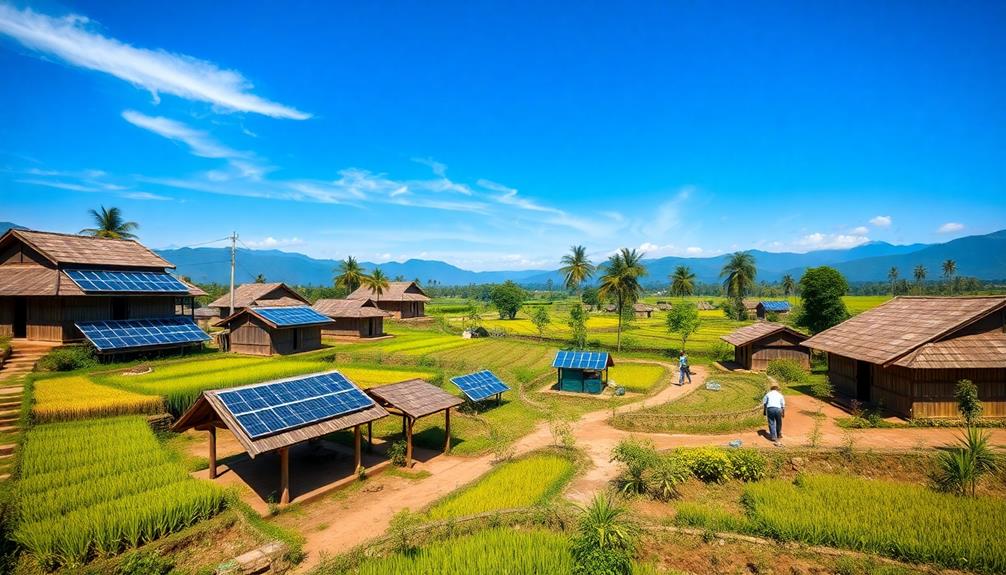
Indonesia's sustainable rural design trends focus on integrating Traditional Ecological Knowledge (TEK) with modern approaches to enhance community resilience. You'll see participatory design methods empowering locals as co-designers, ensuring that their unique needs are met. Initiatives like the Taba Padang village's forest scheme promote sustainable farming while preserving biodiversity. Engagement strategies emphasize collaboration, fostering social innovation and ownership. These trends not only enrich local identity but also improve economic prospects through sustainable practices, like cultivating traditional crops. There's so much more to explore about Indonesia's journey toward sustainability, and these trends are just the beginning.
Key Takeaways
- Integration of Traditional Ecological Knowledge (TEK) enhances sustainable farming practices and aligns agriculture with ecological cycles in rural communities.
- Community-driven initiatives, such as village forest schemes, promote biodiversity and prevent deforestation while improving crop yields.
- Participatory design empowers local residents to co-create sustainable solutions, fostering community engagement and ownership in development projects.
- Ethnographic methods document local cultural practices, ensuring that design outcomes reflect unique community identities and needs.
- Increased market access through improved transportation, like motorbikes, supports economic development and sustainable livelihoods for rural farmers.
Impact of Industrialization and Urbanization
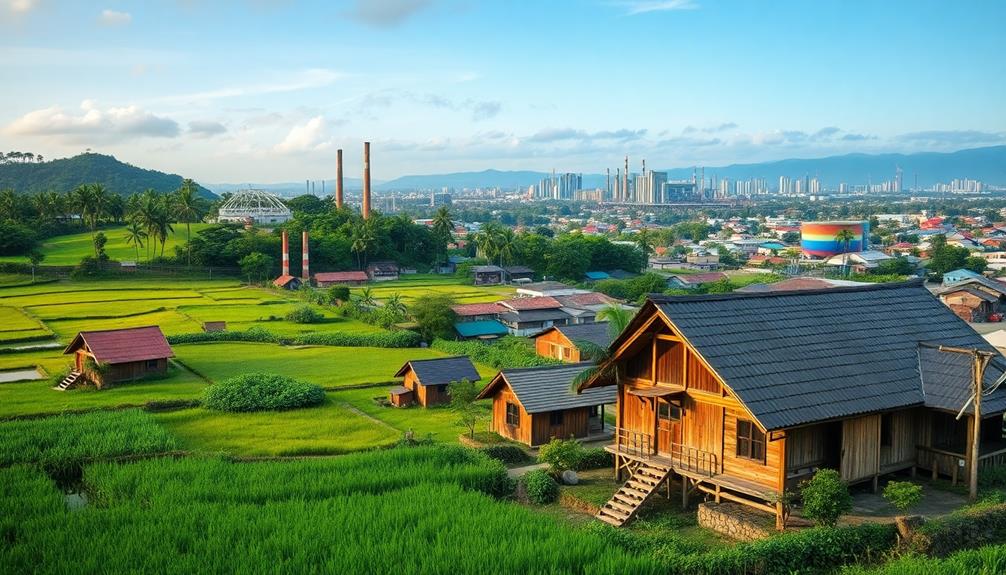
The rapid industrialization and urbanization in Indonesia have profoundly reshaped rural communities and their traditional farming practices. Since the Green Revolution in 1968, mechanized farming techniques have taken root, greatly reducing biodiversity in rural areas.
You may find that the vibrant cultural expressions, such as the Indonesian Decor Mask, are increasingly at risk as these changes take hold. You've likely noticed how urbanization policies have deepened the economic divide, exploiting rural resources and pushing poverty levels higher—12.36% of the rural population faced this challenge as of September 2022.
This shift towards profit-driven, efficient farming hasn't only led to ecological degradation but also eroded cultural practices central to these communities' identities.
As you observe these changes, it's clear that sustainable development is essential for the future of rural Indonesia. Integrating Traditional Ecological Knowledge (TEK) into modern agricultural practices can foster resilience in these communities.
TEK embodies local wisdom and ecological balance, offering invaluable insights that modern methods often overlook. By embracing sustainable design practices that honor these traditions, you can help mitigate the vulnerabilities faced by rural areas, ensuring that their unique cultural heritage and ecological health are preserved.
This approach not only benefits the environment but also strengthens community ties and identity.
Participatory Design and Co-Creation
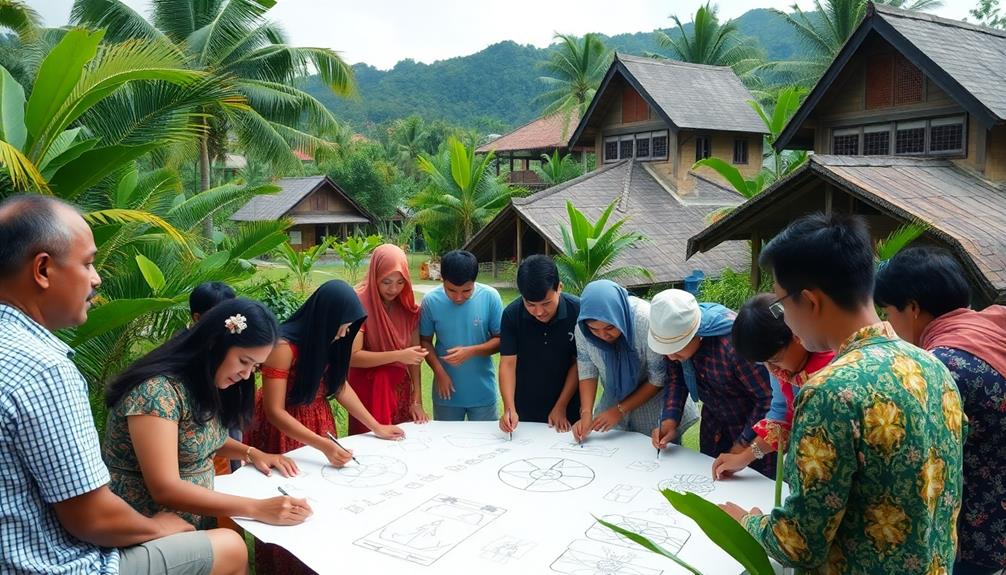
While rural communities in Indonesia face significant challenges from industrialization and urbanization, participatory design and co-creation offer a pathway to empower local residents. This approach emphasizes active involvement, treating community members as co-designers. It fosters social transformation and sustainability by engaging locals in decision-making processes, which is vital as these communities navigate the pressures of modern housing trends and the need for cultural preservation, as seen in the traditional and modern elements of Indonesian housing.
The participatory design process includes five key activities: initiation meetings, treasure mapping, idea generation, craft design workshops, and project reflection. These activities guarantee that everyone's voice is heard, allowing you to contribute to the outcomes that affect your life. Ethnographic methods document local perspectives and cultural activities, reflecting the unique needs and identities of your community.
Co-creation of knowledge enhances local narratives, empowering you and your neighbors to make collective decisions. By integrating Traditional Ecological Knowledge (TEK) into participatory design practices, you strengthen community empowerment and environmental stewardship.
This connection fosters a deeper understanding of sustainable practices that benefit both your community and the environment.
Role of Traditional Ecological Knowledge

Harnessing Traditional Ecological Knowledge (TEK) in Indonesia reveals the invaluable insights local communities possess about their environment and sustainable practices. TEK emphasizes local wisdom, like Niteni, which encourages observing natural phenomena to guide sustainable farming activities.
This approach mirrors the principles found in traditional Indonesian housing, where local materials and ecological awareness shape building practices. By applying the Pranatamangsa system, farmers align their agricultural practices with ecological cycles, enhancing their yields while ensuring sustainability.
Incorporating TEK into modern participatory design practices not only enriches community identity but also fosters pride, driving local engagement in sustainable development initiatives.
This approach promotes environmental stewardship by preserving traditional crop varieties and agricultural methods that are more resilient to climate change.
Community Engagement Strategies

Building on the foundation of Traditional Ecological Knowledge (TEK), community engagement strategies in Indonesia focus on involving local residents as active participants in the design process. This participatory approach encourages you to become a co-designer, fostering social innovation and sustainable development within your community.
For instance, incorporating elements of Indonesian Decorative Pillows can enhance living spaces while reflecting local culture and craftsmanship. In places like Sabrang Village, ethnographic methods help document local cultural practices, ensuring your perspectives and identities shape the design outcomes.
Collaborative workshops bring together local community members and external stakeholders—58 participants in total—to enhance engagement and ownership in development projects. By integrating TEK into these practices, you empower your community with local wisdom and sustainable agricultural methods that promote environmental stewardship.
Moreover, the co-creation of knowledge through participatory learning enriches local narratives, allowing you and your neighbors to collectively tackle challenges and support sustainable regional development.
Case Studies of Sustainable Practices
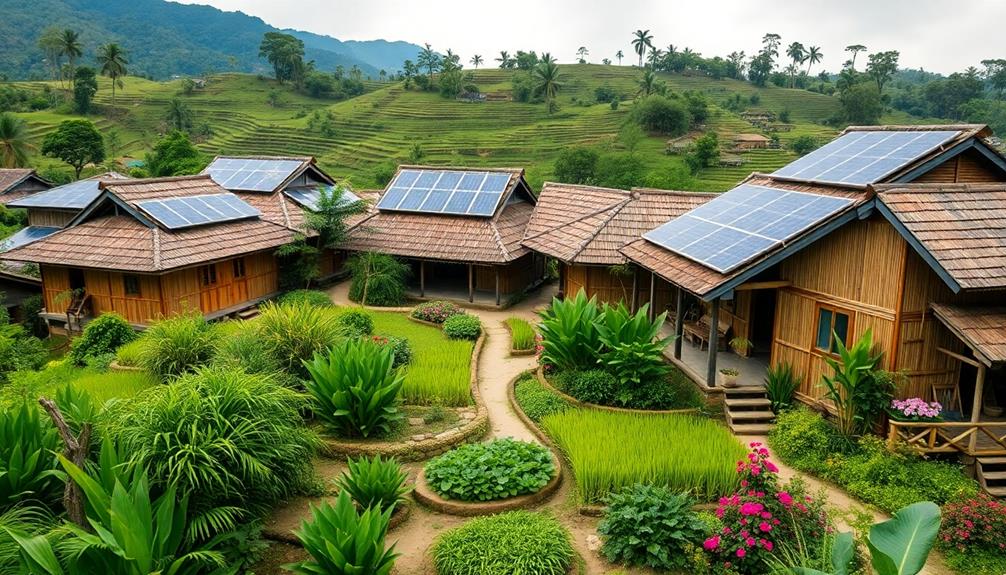
Sustainable practices in Indonesia showcase the transformative power of community-driven initiatives, especially in rural areas. Take Taba Padang village in southwest Sumatra, for example. Here, 470 households have embraced a village forest scheme, managing 1.5 hectares each in a protected forest. This approach promotes sustainable crop growth while preventing deforestation, allowing for the incorporation of local cultural elements into the farming practices, such as traditional planting techniques and community celebrations.
As a result, the community has seen increased incomes from cultivating coffee, pepper, durian, and rattan, which can be further enhanced through events that highlight their unique agricultural products Indonesian Party Decorations.
The introduction of motorbikes for harvest transportation has further improved farming operations, enhancing access to markets and making it easier for farmers to sell their products. Taba Padang's commitment to environmental conservation is evident in their shift from deforestation to reforestation. Regular inspections guarantee everyone adheres to sustainable practices, fostering a sense of responsibility within the community.
Recognized by the Indonesian Ministry of Environment and Forestry, Taba Padang's achievements highlight the potential for eco-tourism, thanks to its natural attractions like waterfalls and hot springs. This case study exemplifies how rural communities can thrive sustainably while protecting the environment, serving as a model for others looking to implement similar practices.
Frequently Asked Questions
What Are the Sustainability Plans of Indonesia?
Indonesia's sustainability plans focus on integrating smart village concepts and renewable energy projects. You'll see initiatives like the Emission Trading Scheme and carbon trading platforms aimed at enhancing community resilience and promoting environmental responsibility.
Why Are Rural Areas More Sustainable?
Imagine a thriving garden, where every plant shares its resources. In rural areas, community ties and traditional knowledge foster sustainability, allowing you to nurture the land and its diversity while ensuring a balanced, harmonious existence.
Conclusion
In Indonesia, the convergence of industrialization and a deep-rooted respect for traditional ecological knowledge creates a unique landscape for sustainable rural design. By embracing participatory design and community engagement, you're not just witnessing a trend; you're part of a transformative movement. Coincidentally, as rural areas adapt to modern challenges, they also revive age-old practices, illustrating that sustainability isn't merely a goal but a harmonious blend of past wisdom and present innovation, shaping a brighter future for all.
Home Decor
Emerging Sustainable Trends in Rural Design
Get ready to discover how innovative sustainable trends in rural design are transforming communities, but what groundbreaking practices are leading the way?
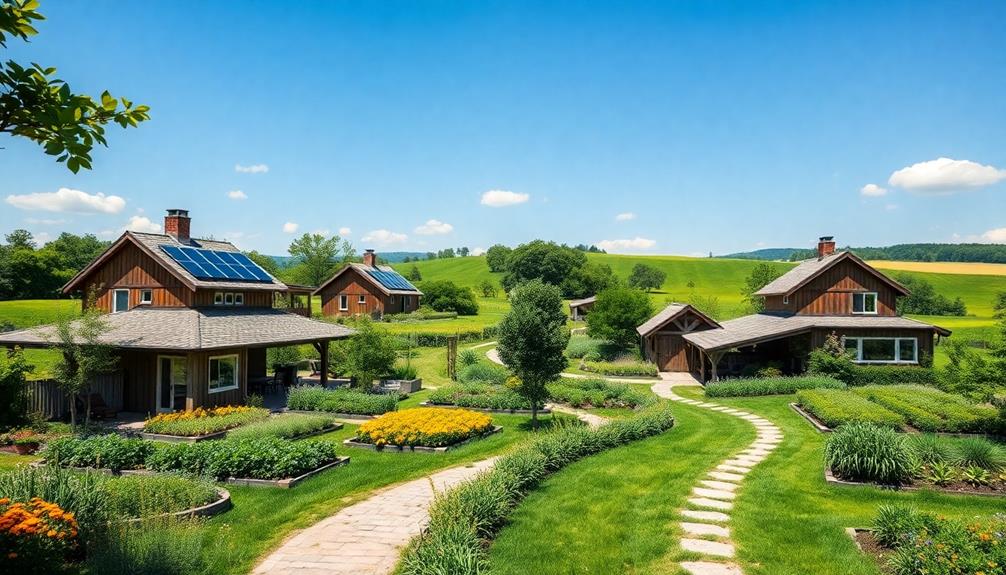
Emerging sustainable trends in rural design focus on eco-friendly practices that promote community resilience and environmental health. By integrating renewable energy solutions like solar panels, you enhance energy independence while reducing costs. Using local, natural materials supports economies and minimizes transportation emissions. Implementing water conservation techniques addresses resource scarcity effectively. Community-centric planning guarantees developments meet local needs and values, fostering social cohesion. Innovations in agriculture, such as precision farming, improve yields and sustainability. These trends not only uplift local economies but also enhance well-being. Keep exploring to uncover even more transformative practices reshaping rural landscapes today.
Key Takeaways
- Sustainable rural design emphasizes renewable energy integration, enhancing energy independence and reducing reliance on non-renewable sources.
- Community-centric planning practices ensure developments resonate with local needs and values, fostering social cohesion and quality of life.
- Nature-inspired design approaches enhance aesthetics and sustainability through passive solar design, green spaces, and local materials.
- Resource efficiency strategies, such as rainwater harvesting and locally sourced materials, significantly reduce waste and operational costs.
- Innovations in agriculture and renewable energy, like organic farming and micro-hydroelectric systems, boost local economies and promote ecological balance.
Overview of Sustainable Rural Design
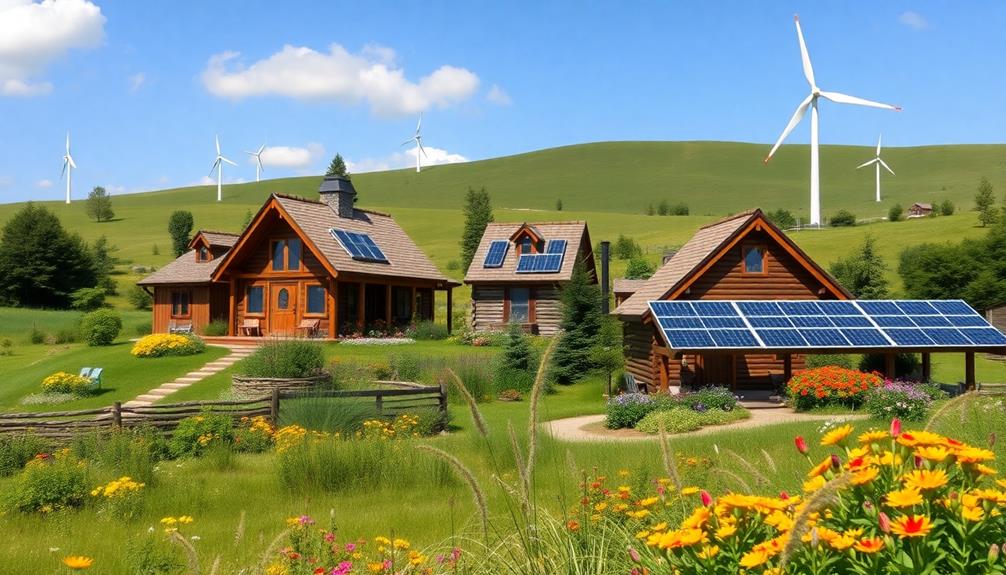
Sustainable rural design is increasingly becoming essential for creating resilient communities that thrive while respecting the environment. By integrating renewable energy solutions like solar panels and wind turbines, you can enhance energy independence in rural areas. These sources not only reduce reliance on fossil fuels but also lower energy costs over time.
Incorporating natural materials, similar to Balinese design characteristics, can further enhance sustainability and create a warm, inviting atmosphere. Using locally sourced materials such as compressed earth blocks can greatly reduce construction expenses while supporting local economies. This approach promotes sustainable living practices that benefit both the community and the environment.
Additionally, implementing water conservation techniques, including rainwater harvesting and greywater recycling, addresses pressing water scarcity issues effectively. Incorporating biophilic design principles into rural structures fosters a connection with nature, enhancing the well-being of occupants through green spaces and natural light.
You'll find that innovative housing solutions, like modular homes, offer cost-effective and energy-efficient options. These designs minimize construction waste and time while promoting eco-friendly practices.
Key Principles of Ecological Design
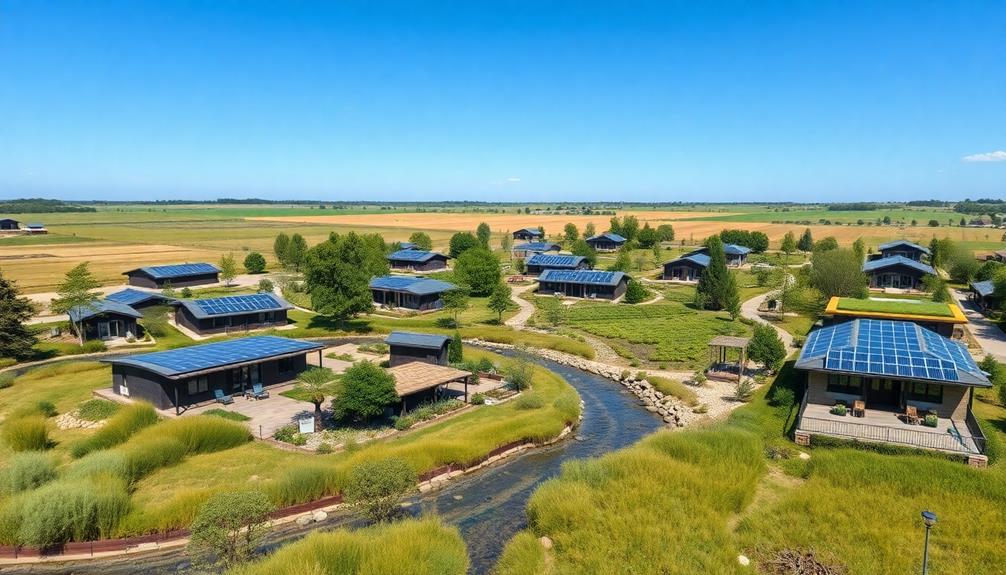
When you think about ecological design, consider how nature-inspired approaches can shape your projects.
Emphasizing harmony with nature, as seen in traditional Indonesian style home decor, can enhance the aesthetic while promoting sustainability.
You'll want to focus on resource efficiency strategies that minimize waste and maximize sustainability.
Plus, incorporating community-centric planning practices guarantees that your designs truly reflect the needs and values of the people living in those spaces.
Nature-Inspired Design Approaches
Embracing nature-inspired design approaches can transform rural architecture into vibrant, sustainable spaces that harmonize with their surroundings. By prioritizing biomimicry, you can emulate natural forms and processes, creating efficient structures that work seamlessly with ecosystems.
These sustainable architecture practices often utilize local materials and traditional building techniques, such as those found in traditional Indonesian housing, which reduce carbon footprints and celebrate cultural heritage.
Key elements of nature-inspired design include:
- Passive solar design: Optimize building orientation and thermal mass to cut energy consumption.
- Ecological design: Integrate green spaces and native landscaping to enhance biodiversity and improve air quality.
- Water management strategies: Implement natural ponds and rain gardens for effective water conservation.
- Local materials: Use materials sourced from nearby to minimize transportation emissions.
- Wildlife habitats: Create environments that support local fauna, promoting ecological balance.
Resource Efficiency Strategies
Resource efficiency strategies play a pivotal role in ecological design, building on the foundation of nature-inspired approaches. By prioritizing locally sourced materials, you can greatly reduce transportation emissions while supporting local economies.
For example, incorporating elements from traditional Indonesian wedding decor ideas can enhance community connections through locally sourced floral arrangements and handcrafted decor. Take, for instance, the rising popularity of compressed earth blocks and bamboo construction—these options embody sustainable choices.
Implementing rainwater harvesting systems and greywater recycling is another effective strategy. You could reduce water consumption by up to 50%, promoting sustainable water use in your community.
Furthermore, integrating renewable energy sources like solar panels and small wind turbines not only enhances energy independence but can also cut household energy costs by 30-50%.
Utilizing passive solar design techniques, such as strategic building orientation and thermal mass, helps you maximize natural heating and cooling, potentially reducing energy use for temperature regulation by 20-40%.
Additionally, embracing eco-friendly product designs, like low-cost cooking stoves and efficient irrigation systems, can lower resource consumption and operational costs.
These strategies collectively improve the quality of life for rural residents, making your community more sustainable and resilient in the long run.
Community-Centric Planning Practices
Community-centric planning practices are essential for fostering sustainable rural development that truly reflects the needs and values of local residents. By prioritizing community engagement and participatory design, you can guarantee that developments resonate with the people who'll use them.
Significantly, traditional Indonesian houses, such as Rumah Adat, emphasize community-oriented layouts that encourage social interaction and a sense of belonging. Studies have shown that this approach can lead to a 30% increase in community satisfaction.
Utilizing ecological design principles, such as:
- Incorporating local materials to reduce emissions and costs
- Designing green spaces that boost social cohesion and safety
- Integrating renewable energy solutions for economic resilience
- Promoting sustainable agricultural practices to enhance biodiversity
- Creating shared public areas that foster community interaction
These strategies not only support economic development but also enhance the quality of life in rural areas.
For instance, using compressed earth blocks can cut construction costs by 20%, while renewable energy solutions can reduce energy costs by 50%. By focusing on sustainable practices, you can create vibrant, thriving communities that prioritize both ecological health and resident well-being.
Embracing these community-centric approaches guarantees a holistic development model that benefits both people and the planet.
Community-Centric Planning Approaches
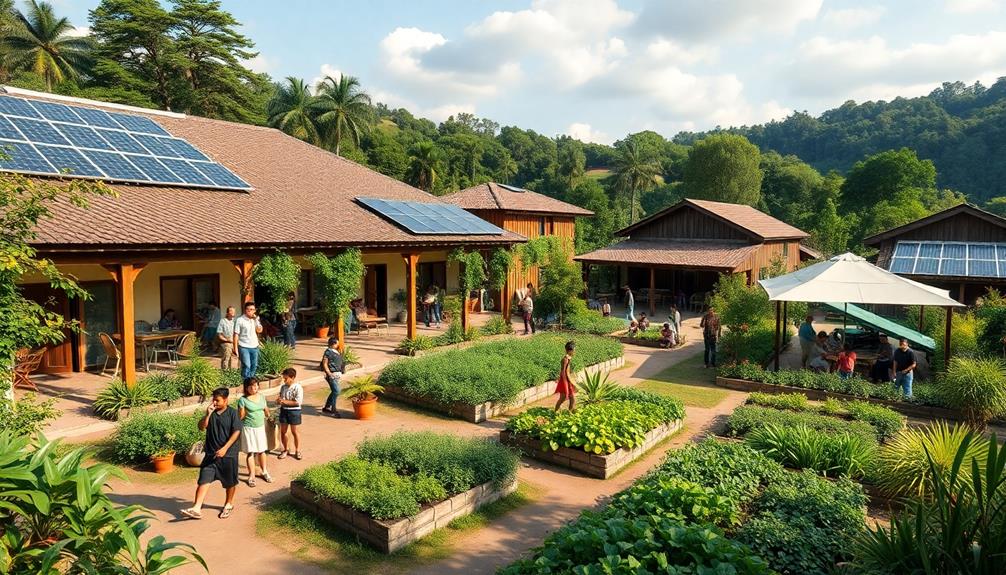
When you embrace participatory design methods, you empower your community to shape its own future.
Incorporating elements of local culture, such as Indonesian Decorative Pillows, can enhance the sense of identity and belonging among residents.
Engaging local residents not only enhances their connection to the area but also guarantees that developments truly reflect their needs and values.
Participatory Design Methods
Participatory design methods empower residents to take an active role in shaping their environment, guaranteeing that projects align with local needs and values. By engaging community members in the planning process, you foster a sense of community ownership and pride.
This approach can also reflect local craftsmanship, similar to how the intricate designs of Indonesian decor masks enhance cultural appreciation in various settings. Studies show that projects that involve local input are 30% more likely to be accepted and utilized, creating sustainable solutions that truly reflect the community's unique characteristics.
Here are some key aspects of participatory design:
- Inclusivity: Engaging diverse backgrounds guarantees all voices are heard.
- Workshops: Collaborative sessions allow community members to share their ideas.
- Cultural relevance: Designs become contextually appropriate, reflecting local traditions.
- Social cohesion: Strengthening relationships among residents improves overall quality of life.
- Empowerment: Community members gain confidence in their ability to influence change.
Enhancing Local Engagement
Engaging local residents in the planning process not only builds on the principles of participatory design but also fosters a deeper connection to the projects that shape their environment.
When you prioritize community input, you guarantee developments reflect local traditions and values, enhancing inclusivity. This approach cultivates a sense of ownership, making residents more likely to embrace and utilize community projects.
By integrating elements of tropical architecture that resonate with local culture, such as open spaces and natural light, you can further enhance the sense of belonging within the community.
Involving diverse stakeholders, including marginalized groups, promotes social cohesion and addresses historical disparities in rural development.
By integrating local knowledge, you're more likely to identify unique environmental and social considerations that standard practices might overlook, leading to sustainable outcomes.
Moreover, successful community engagement has been linked to improved mental health and well-being.
When you strengthen social networks and create spaces that encourage interaction, you support community activities that enhance overall quality of life.
Innovations in Renewable Energy

Rural areas are witnessing a surge in renewable energy innovations that are transforming how communities power their lives. By investing in sustainable energy sources, you can enhance energy independence and greatly reduce greenhouse gas emissions.
For instance, solar energy is projected to account for about 20% of global electricity generation by 2040, making it a key player in rural energy strategies. The emphasis on sustainable craftsmanship in Balinese furniture also reflects a growing trend towards eco-friendly practices in various sectors.
Consider the benefits of these innovations:
- Micro-hydroelectric systems: Harness flowing water to create decentralized energy solutions, cutting costs by up to 30%.
- Solar-powered irrigation systems: Boost agricultural efficiency, potentially increasing crop yields by 20-30%.
- Wind energy projects: Provide reliable power while supporting local job opportunities in the renewable energy sector.
- Energy independence: Reduces reliance on non-renewable sources, allowing rural communities to thrive sustainably.
- Economic growth: The renewable energy sector is expected to create over 24 million jobs globally by 2030.
Sustainable Agriculture Practices

Sustainable agriculture practices are revolutionizing how we produce food while minimizing environmental impact. By focusing on efficient resource management and innovative techniques, these practices not only enhance food production but also promote biodiversity conservation. You can see how various methods contribute to sustainable food sources in the table below:
| Practice | Benefits |
|---|---|
| Organic Farming | Reduces chemical use |
| Precision Farming | Increases crop yields by 20-30% |
| Agroecological Practices | Enhances ecosystem health |
| Water Management Innovations | Cuts water usage by up to 30% |
| Local Seasonal Production | Supports food security in rural communities |
Adopting these sustainable agriculture practices addresses critical challenges, including water scarcity and the need for food security. By emphasizing local food production, you can strengthen rural economies and foster community resilience. As the organic farming market is projected to reach $500 billion by 2025, it's clear that the shift toward sustainability is not just beneficial but essential for our future. Embrace these practices to help create a more sustainable world.
Enhancing Local Economies
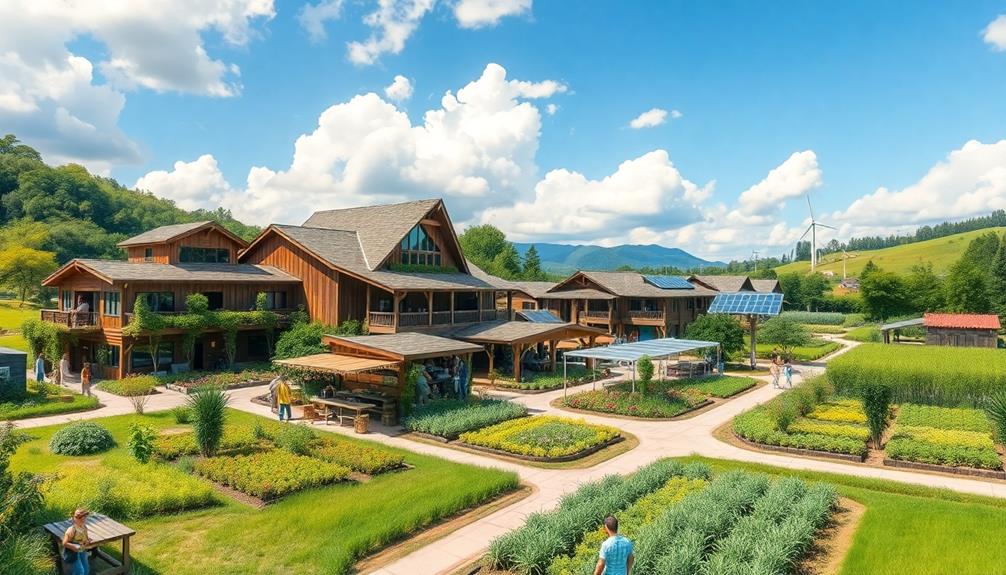
Investing in sustainable agriculture practices not only boosts food production but also lays the groundwork for enhancing local economies. By focusing on rural development, you're supporting initiatives that contribute around 30% to global GDP.
Additionally, incorporating elements of traditional artistry, such as Indonesian decor masks, can celebrate local culture and attract tourism, further promoting economic growth. This investment fosters economic growth and diversifies income sources, as non-farm activities now account for up to 50% of rural income in some areas.
Consider the following strategies to enhance local economies:
- Support renewable energy projects that create jobs and reduce dependency on non-renewable sources.
- Encourage sustainable entrepreneurship by providing training and resources for local business owners.
- Promote infrastructure investment, such as improved transportation networks, to enhance market access for local products.
- Expand access to financial services, including microfinance options, to empower entrepreneurs and stimulate economic development.
- Develop community programs that foster collaboration and knowledge-sharing among local businesses.
These sustainable practices not only improve the quality of life in rural areas but also create a robust ecosystem that drives long-term economic stability.
Health and Well-being in Design
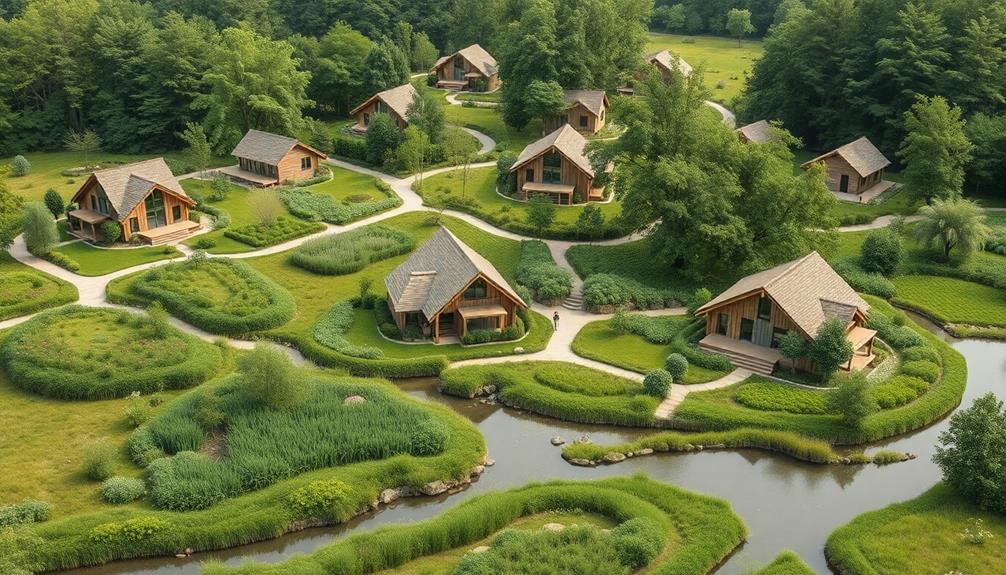
There's a growing recognition that the design of our living spaces greatly impacts health and well-being. By integrating biophilic design principles, you can create environments that foster mental well-being and reduce stress. Access to green spaces not only enhances air quality but also encourages physical activity, leading to improved physical health outcomes.
Natural light and proper ventilation are essential in rural homes, enhancing indoor comfort and productivity. Additionally, using eco-friendly materials minimizes indoor air pollutants, creating a healthier living environment. Community engagement is significant as it helps foster social connections, enhancing a sense of belonging that is fundamental for mental health.
Here's a quick summary of these key aspects:
| Design Element | Benefits |
|---|---|
| Biophilic Design | Reduces stress, boosts mental well-being |
| Access to Green Spaces | Improves air quality, enhances physical health |
| Natural Light | Increases comfort and productivity |
| Eco-Friendly Materials | Lowers indoor pollutants for healthier living |
Incorporating these elements not only promotes individual well-being but also strengthens community ties, ultimately leading to a healthier rural lifestyle.
Future Directions for Rural Development
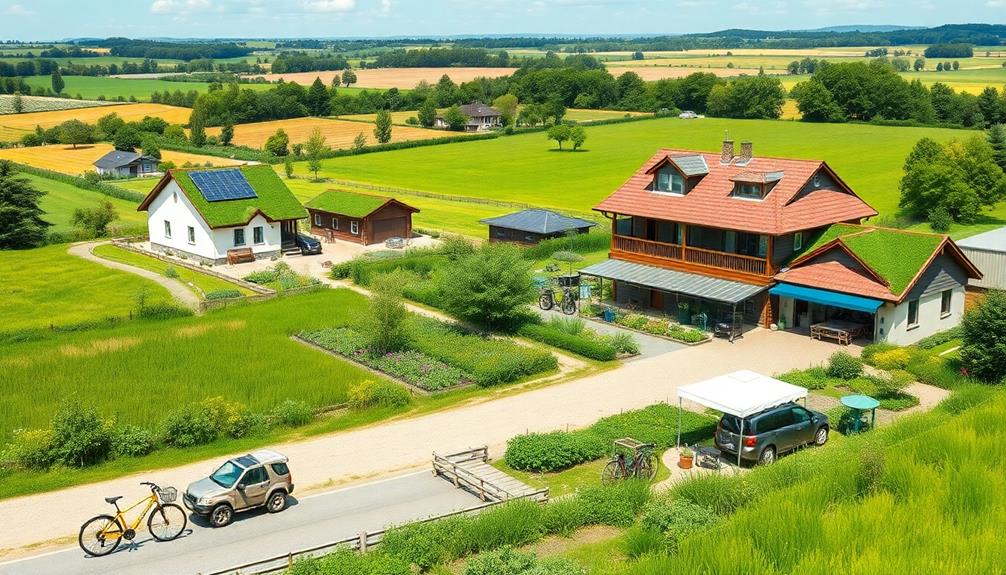
As rural development evolves, a clear focus on sustainable agriculture practices will shape the future landscape of these communities.
You'll see an increasing emphasis on innovative solutions that enhance food security and drive economic growth. The organic farming market, projected to reach $500 billion by 2025, is just one example of how sustainable development can transform rural areas.
Consider these key trends that will define future rural development:
- Investment in infrastructure: Improved transportation and utilities will create better access to markets.
- Precision farming technologies: These advancements promise to boost crop yields by 20-30%, optimizing natural resources.
- Rural entrepreneurship: Non-farm activities can contribute up to 50% of rural income, fostering innovation and job creation.
- Energy efficiency initiatives: Adopting eco-friendly living practices will reduce waste and enhance sustainability.
- Access to education: Educational programs will empower residents, equipping them with skills for new employment opportunities.
As you engage with these developments, you'll witness a more resilient and sustainable future for rural communities, ultimately leading to a thriving, eco-friendly lifestyle.
Frequently Asked Questions
What Are the Examples of Sustainable Development in Rural Areas?
You'll find examples of sustainable development in rural areas like renewable energy projects, organic farming, eco-friendly modular housing, community-driven design, and innovative water management systems, all enhancing local independence, efficiency, and environmental conservation.
How to Promote Sustainability in Rural Areas?
Imagine a future where your community thrives—by adopting renewable energy, sustainable agriculture, eco-friendly housing, and efficient water management. You can engage locals, ensuring their needs shape projects, fostering lasting change and shared ownership of a sustainable tomorrow.
What Are the Sustainable Development Goals of Rural Development?
The sustainable development goals for rural development focus on eradicating poverty, ensuring food security, managing water resources, promoting economic growth, and enhancing urban-rural connections. You'll play a key role in achieving these goals through local initiatives.
What Are the Challenges of Rural Sustainability?
Rural regions wrestle with resource restraints, aging populations, and climate changes. You'll face fragmented infrastructure and limited community involvement, making it tough to tackle sustainability challenges effectively and foster vibrant, resilient rural futures.
Conclusion
As you embrace these emerging sustainable trends in rural design, you'll cultivate greener landscapes, nurture stronger communities, and inspire healthier lifestyles. By prioritizing ecological principles, harnessing renewable energy, and supporting local economies, you'll create vibrant spaces that thrive today and tomorrow. Picture thriving farms, bustling markets, and interconnected neighborhoods, all blossoming under the sun of sustainability. Together, let's pave the way for a brighter, more resilient rural future, where nature and community flourish hand in hand.
-

 Vetted4 months ago
Vetted4 months ago14 Best Personalized Father's Day Gifts for Your Husband – Show Him You Care
-

 Alfresco4 months ago
Alfresco4 months agoAlfresco Stacker Doors: Seamless Indoor-Outdoor Living!
-

 Vetted5 months ago
Vetted5 months ago15 Best EMS Foot Massagers for Neuropathy to Soothe Your Feet
-

 Craft and Textiles6 months ago
Craft and Textiles6 months ago15 Best Places to Buy Appliances for Your Home – Top Retailers Reviewed
-

 Craft and Textiles6 months ago
Craft and Textiles6 months ago15 Best Gifts for 4-Year-Old Girls That Will Spark Joy and Creativity
-

 Craft and Textiles6 months ago
Craft and Textiles6 months ago15 Best Battery-Powered Leaf Blowers for Effortless Yard Work
-

 Craft and Textiles6 months ago
Craft and Textiles6 months ago15 Best Cordless Mowers for Effortless Lawn Care – Top Picks of 2024
-

 Tableware and Dining Accessories6 months ago
Tableware and Dining Accessories6 months agoWhat Is the Hindi Meaning of Tableware





























